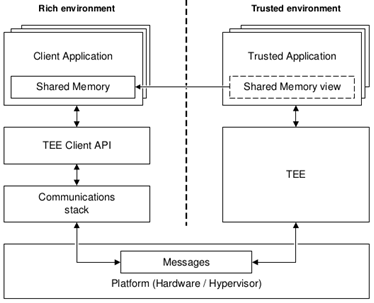TEE Communication
NoteTEEC API is deprecated since Tizen 6.5 and will be removed after two releases without any alternatives.
You can create secure communications by executing your application in a trusted execution environment (TEE), and communicating with other applications within that environment. To implement TEE communication, you can use the libteec API, which is based on the GlobalPlatform® TEE Client API.
You can run applications in 2 environments: a rich world (like Linux) with client applications (CA) and a secure world with trusted applications (TA).
Figure: TEE communication architecture

The main features of the Tizen.Security.TEEC namespace include the following:
-
Connecting to a trusted application
You can securely connect to a trusted application by creating a new session.
-
Sending commands to a trusted application
You can pass commands from a client application to a trusted application, including using shared memory blocks.
Prerequisites
To enable your application to use the TEE communication functionality, follow the steps below:
-
To make your application visible in the official site for Tizen applications only for devices that support TEE communication, the application must specify the following feature in the
tizen-manifest.xmlfile:XMLCopy<feature name="http://tizen.org/feature/security.tee"/>You can also check whether a device supports the Tizen.Security.TEEC namespace by using the
TryGetValue()method of the Tizen.System.Information class and, accordingly, enabling or disabling the code requiring the namespace:C#Copyconst string TEEC_FEATURE_KEY = "http://tizen.org/feature/security.tee"; bool ret; if (Information.TryGetValue<bool>(TEEC_FEATURE_KEY, out ret) == false) { /// Error handling }Note
In TV applications, you can test the TEE communication functionality on an emulator only. Most target devices do not currently support this feature.
-
To use the methods and properties of the Tizen.Security.TEEC namespace, include it in your application:
C#Copyusing Tizen.Security.TEEC; -
Initialize a new TEEC context by creating an instance of the Tizen.Security.TEEC.Context class:
C#CopyContext ctx = new Context(null);When it is no longer needed, destroy the TEEC context:
C#Copyctx.Dispose();
Connect applications
To communicate between applications, you must connect a client application to a trusted application by creating a session, follow the steps below:
-
Open a session with the
OpenSession()method of the Tizen.Security.TEEC.Context class, which returns the session as a new instance of the Tizen.Security.TEEC.Session class:C#CopyGuid ta_uuid = new Guid(" "); /// Trusted application GUID try { Session ses = ctx.OpenSession(ta_uuid); -
When it is no longer needed, close the session with the
Close()method of theTizen.Security.TEEC.Sessionclass:C#Copyses.Close(); } catch (Exception e) { /// Error handling }
Send secure commands
After opening a session with a trusted application, a client application can execute functions in the trusted application by sending secure commands to the trusted application.
To send function call commands, follow the steps below:
-
To send a command for invoking a function without parameters, use the
InvokeCommand()method of the Tizen.Security.TEEC.Session class, with the first parameter identifying the function to be executed by the trusted application:C#Copytry { ses.InvokeCommand(1, null); } catch (Exception e) { /// Error handling } -
To send a command for invoking a function with simple integer parameters:
-
Create the parameters as new instances of the Tizen.Security.TEEC.Value class:
C#Copytry { Value p1 = new Value(1, 2, TEFValueType.InOut); Value p2 = new Value(10, 200, TEFValueType.InOut); -
Send the command to the trusted application with the
InvokeCommand()method of theTizen.Security.TEEC.Sessionclass. The second parameter is a new instance of the Tizen.Security.TEEC.Parameter class containing the 2 integer parameter values:C#Copyses.InvokeCommand(1, new Parameter[] {p1, p2}); } catch (Exception e) { /// Error handling }
-
-
To send a command for invoking a function with a local memory reference as a parameter:
-
Create a temporary memory reference as a new instance of the Tizen.Security.TEEC.TempMemoryReference class:
C#Copytry { long val = 10; TempMemoryReference p1 = new TempMemoryReference((IntPtr)(&val), 1024, TEFTempMemoryType.InOut); -
Send the command to the trusted application with the
InvokeCommand()method of theTizen.Security.TEEC.Sessionclass. The second parameter is a new instance of theTizen.Security.TEEC.Parameterclass containing the memory reference:C#Copyses.InvokeCommand(1, new Parameter[] {p1}); } catch (Exception e) { /// Error handling }
-
Use shared memory
To share a memory block between a client application and a trusted application, follow the steps below:
-
To send a function call command to the trusted application, including an allocated shared memory reference:
-
Allocate a new memory block as shared memory with the
AllocateSharedMemory()method of the Tizen.Security.TEEC.Context class, which returns the block as a new instance of the Tizen.Security.TEEC.SharedMemory class:C#Copytry { SharedMemory shm = ctx.AllocateSharedMemory(1024, SharedMemoryFlags.InOut); -
Register a memory reference based on the shared memory block by creating a new instance of the Tizen.Security.TEEC.RegisteredMemoryReference class, and send the function call command to the trusted application with the
InvokeCommand()method of the Tizen.Security.TEEC.Session class. The registered memory reference is passed in a new instance of the Tizen.Security.TEEC.Parameter class:C#CopyRegisteredMemoryReference p1 = new RegisteredMemoryReference(shm, 1024, 0, RegisteredMemoryReference.InOut); ses.InvokeCommand(1, new Parameter[] {p1}); -
Release the shared memory:
C#Copyctx.ReleaseSharedMemory(shm); } catch (Exception e) { /// Error handling }
-
-
To send a function call command to the trusted application, including an external shared memory reference:
-
Register a block of existing client application memory as shared memory with the
RegisterSharedMemory()method of theTizen.Security.TEEC.Contextclass, which returns the block as a new instance of theTizen.Security.TEEC.SharedMemoryclass:C#Copytry { IntPtr memaddr = <Some memory address>; SharedMemory shm = ctx.RegisterSharedMemory(memaddr, 1024, SharedMemoryFlags.InOut); -
Register a memory reference based on the shared memory block by creating a new instance of the
Tizen.Security.TEEC.RegisteredMemoryReferenceclass, and send the function call command to the trusted application with theInvokeCommand()method of theTizen.Security.TEEC.Sessionclass. The registered memory reference is passed in a new instance of theTizen.Security.TEEC.Parameterclass:C#CopyRegisteredMemoryReference p1 = new RegisteredMemoryReference(shm, 1024, 0, RegisteredMemoryReference.InOut); ses.InvokeCommand(1, new Parameter[] {p1}); -
Release the shared memory:
C#Copyctx.ReleaseSharedMemory(shm); } catch (Exception e) { /// Error handling }
-
Related information
- Dependencies
- Tizen 4.0 and Higher